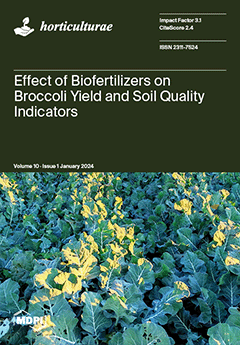Ginkgo (
Ginkgo biloba L.) is a cherished relic among plants, commonly planted as a street tree. However, it faces cultivation challenges due to escalating soil salinization and widespread snowmelt application. Therefore, this study used 4-year-old
Ginkgo seedlings to investigate how exogenous melatonin at varying concentrations affects seedling growth and physiology under salinity stress. The results revealed that appropriate melatonin concentrations (0.02, 0.1 mmol·L
−1) significantly mitigated leaf yellowing under different NaCl stress levels. Furthermore, they increased ground diameter, current-year branch growth, relative water concentration, free proline, and soluble sugars in leaves. Melatonin also reduced electrolyte exudation rates, flavonoids, and malonic dialdehyde concentration, while enhancing peroxidase and superoxide dismutase activities. This led to reduced chlorophyll content, photosynthetic rate, stomatal conductance, and transpiration rate, stabilizing intercellular CO
2 concentration, preserving photosynthetic structures, and enhancing photosynthetic rates. Additionally, the decline in the photosynthetic electron transport rate, the effective photochemical quantum yield of PSII, and the potential efficiency of primary conversion of light energy of PSII was alleviated. Minimal fluorescence and the non-photochemical quenching coefficient also improved. However, high melatonin concentration (0.5 mmol·L
−1) exacerbated salinity stress. After analyzing composite scores, the 0.02 mmol·L
−1 melatonin treatment was most effective in alleviating NaCl stress, while the 0.5 mmol·L
−1 treatment intensified physiological stress under 200 mmol·L
−1 NaCl stress. Principal component analysis and correlation analysis identified seven physiological indicators (photosynthetic rate, transpiration rate, photosynthetic electron transport rate, minimal fluorescence, superoxide dismutase, free proline, and chlorophyll a) and three growth indicators (ground diameter, branch length, and current-year branch thickness) as key markers for rapid salinity stress assessment in
Ginkgo. These findings are crucial for addressing challenges associated with snowmelt’s impact on roadside
Ginkgo trees, expanding planting areas, and breeding exceptional salt-tolerant
Ginkgo varieties.
Full article





